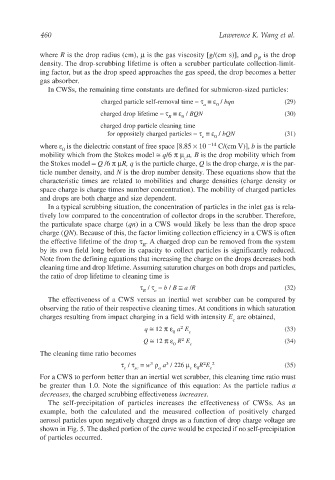Page 488 - Air Pollution Control Engineering
P. 488
12_ch_wang.qxd 05/05/2004 5:26 pm Page 460
460 Lawerence K. Wang et al.
where R is the drop radius (cm), µ is the gas viscosity [g/(cm s)], and ρ is the drop
R
density. The drop-scrubbing lifetime is often a scrubber particulate collection-limit-
ing factor, but as the drop speed approaches the gas speed, the drop becomes a better
gas absorber.
In CWSs, the remaining time constants are defined for submicron-sized particles:
charged particle self-removal time = τ ≡ε / bqn (29)
a 0
charged drop lifetime =τ ≡ε / BQN (30)
R 0
charged drop particle cleaning time
for oppositely charged particles =τ ≡ε / bQN (31)
c 0
where ε is the dielectric constant of free space [8.85 × 10 −14 C/(cm V)], b is the particle
0
mobility which from the Stokes model ≅ q/6 πµ a, B is the drop mobility which from
c
the Stokes model = Q /6 π µR, q is the particle charge, Q is the drop charge, n is the par-
ticle number density, and N is the drop number density. These equations show that the
characteristic times are related to mobilities and charge densities (charge density or
space charge is charge times number concentration). The mobility of charged particles
and drops are both charge and size dependent.
In a typical scrubbing situation, the concentration of particles in the inlet gas is rela-
tively low compared to the concentration of collector drops in the scrubber. Therefore,
the particulate space charge (qn) in a CWS would likely be less than the drop space
charge (QN). Because of this, the factor limiting collection efficiency in a CWS is often
the effective lifetime of the drop τ . A charged drop can be removed from the system
R
by its own field long before its capacity to collect particles is significantly reduced.
Note from the defining equations that increasing the charge on the drops decreases both
cleaning time and drop lifetime. Assuming saturation charges on both drops and particles,
the ratio of drop lifetime to cleaning time is
τ / τ = b / B ≅ a /R (32)
R c
The effectiveness of a CWS versus an inertial wet scrubber can be compared by
observing the ratio of their respective cleaning times. At conditions in which saturation
charges resulting from impact charging in a field with intensity E are obtained,
c
2
q ≅ 12 π ε a E (33)
0 c
2
Q ≅ 12 π ε R E (34)
0 c
The cleaning time ratio becomes
2
3
3
τ / τ = w ρ a / 226 µ ε R E 2 (35)
c sc a c 0 c
For a CWS to perform better than an inertial wet scrubber, this cleaning time ratio must
be greater than 1.0. Note the significance of this equation: As the particle radius a
decreases, the charged scrubbing effectiveness increases.
The self-precipitation of particles increases the effectiveness of CWSs. As an
example, both the calculated and the measured collection of positively charged
aerosol particles upon negatively charged drops as a function of drop charge voltage are
shown in Fig. 5. The dashed portion of the curve would be expected if no self-precipitation
of particles occurred.

